 2
Issue 2
2
Issue 2
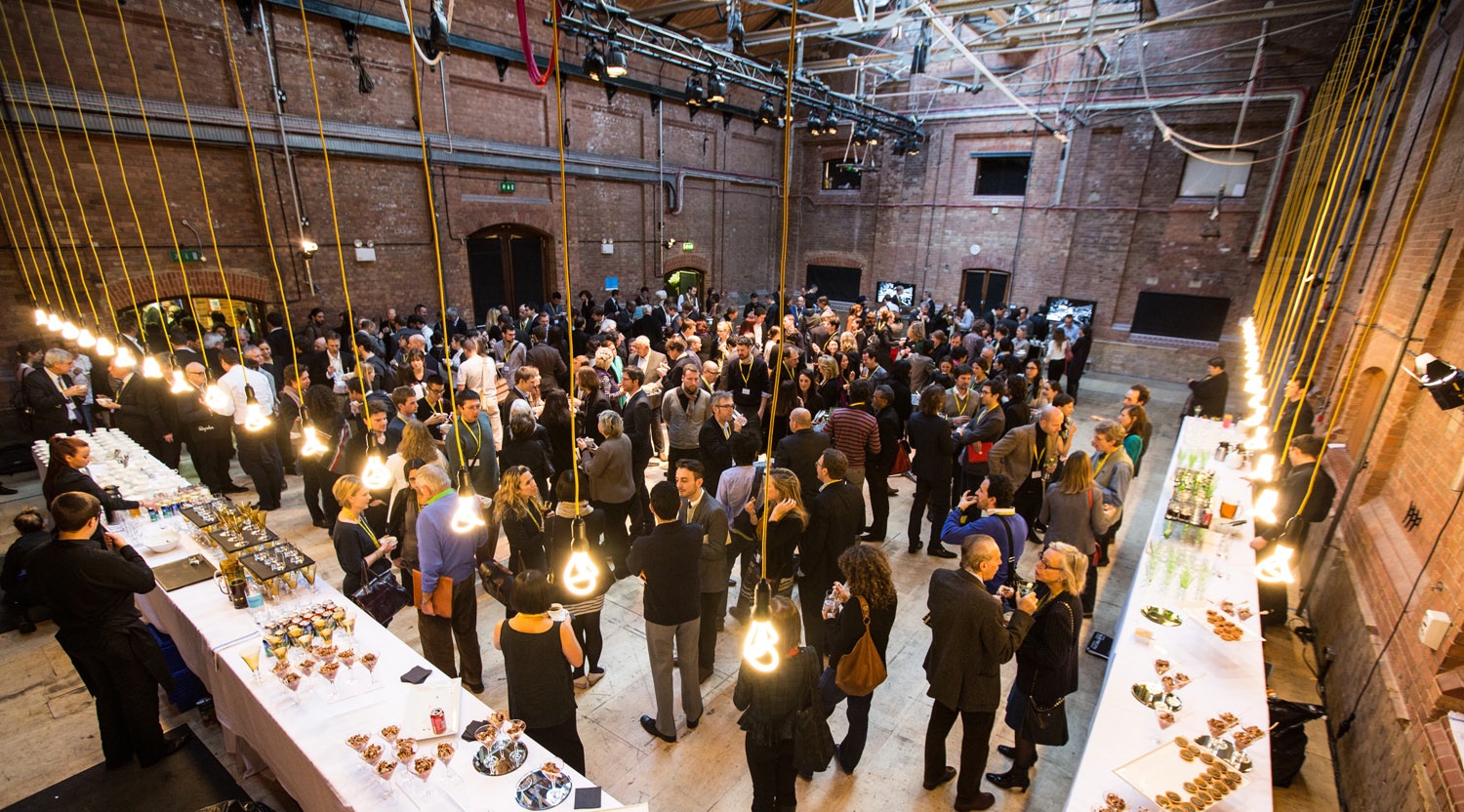
Electric City, participants at break time, day 2, 6-7 December 2012.
Technology is the answer. But what is the question? Electric City, the 11th Urban Age conference
How can urban technologies be used more intelligently, asked the organisers of the Electric Age, the latest Urban Age conference held at the Shoreditch Electric Light Station from 6-7 December 2012. In answer to Cedric Price’s provocation, this turns out to be a matter of greater experimentation and awareness regarding the social dimensions of smart cities in an ecologically challenging age.
Technology is the answer. But what is the question?, the radical architect Cedric Price (1933-2003) once asked, and it remains just as pressing an issue today. Now we ask what characterises digital urban futures. Can’t a greater willingness to speculate on needs create better results? And what do we have to do to reshape the present urban conditions in order to achieve them? How can we ensure our processes are more integrated rather than carried out in silos, and make room for people in ‘smart city’ visions?
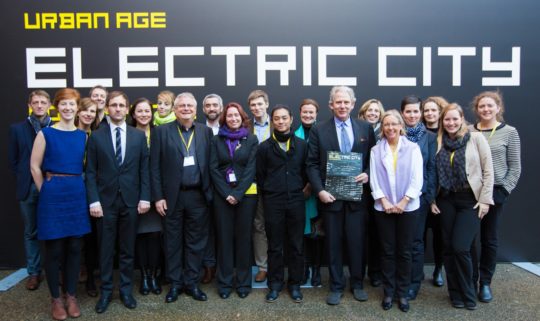
The Electric City team from LSE Cities.
‘Smartness’ proliferated as a purely commercialized concept cannot be the answer. In this age of the Internet of Things, as we lean ever more on the seductive support of digital infrastructure, the big question is, can we evolve a critical understanding of how to evolve digital-physical thresholds in their social implications? That way, the clues will start to build up rapidly.
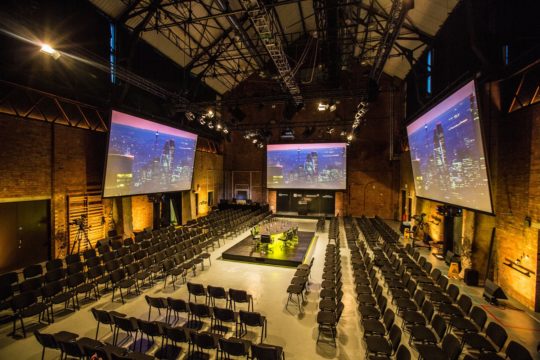
Electric City auditorium at the Shoreditch Electric Light Station, Shoreditch, at the start of the conference.
Imparted urban knowledge and discourse can, at best, create an immense glow of light, and when you put over 60 speakers from 30 cities in 15 countries across four continents together to grapple with these issues as the organizers of Electric City, the latest Urban Age conference, stylishly staged at the Shoreditch Electric Light Station on 6-7 December 2012 (with technical support from Triad Berlin), did, some sparky transcendence of disciplinary barriers becomes possible. Urban Age has always aspired to being this kind of highwire participatory act. It is a truly worldwide investigation into the socio-spatial dynamics of cities that has been in motion since 2005, organized by LSE Cities and the Alfred Herrhausen Society, involving over 10 conferences. As its latest ‘urban laboratory’ aimed at catalyzing the exchange of information, experiences and data, Electric City garnered an inordinate share of illuminating moments and debate. Pragmatic advice, a plethora of visions and some predictable realities came as part of the show.
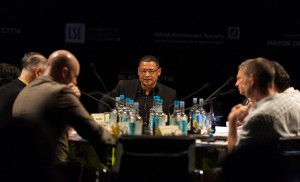
Edgar Pieterse, chairing Infrastructures for Social Progress: a Global Outlook.
Urban Age is skilled in balancing focus on the developing and developed world, so on this occasion there could have perhaps been more on the issues of digital agency in the global south, although august speakers like Edgar Pieterse, Director of the African Centre for Cities, Ken Banks, Founder, Kiwanja Foundation, and Enrique Peñalosa, former Mayor of Bogota (1998-2001) made excellent contributions. This is a part of the globe where mobile phones have already become a key part of communication and basic necessity. Nigeria, for example, has close to 100 million mobile phone lines, making it Africa’s largest telecoms market, according to statistics by the NCC, and the mobile has transformed life in areas of education, banking, activism, entertainment, disaster management, agriculture and in the area of health, through e-health and mobile health programmes. FrontlineSMS, founded by Banks, who has been working in rural communities in Africa since 1993, builds open source software including SMS for empowering two-way communication for social change programmes on a big scale in locations without Internet access.
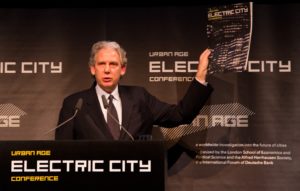
Ricky Burdett introducing the themes of Electric City.
Whether global north and south, a deeper political analysis of digital technologies in relation to economic and urban planning is vital.
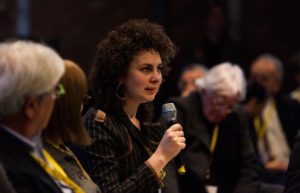
Vasiliki Malakasi speaks from the audience.
Because in the 3rd Industrial Revolution of Internet technology and renewable energy, there are tools and processes, high tech and low tech, that can be unlocked, which in aggregation, can avoid a Silicon Valley-style, dotcom-driven urban evolution, bringing yet another enclave divorced from the wider realities of the downtown. Therefore the inclusion of audience comments and questions for this latest Urban Age conference, not usually part of the programme, made for an extra vivid mix of voices. It also helped to leaven the certain milieu on stage of party political, neo-liberal perspectives built up on the first day, later rebalanced by the more activist perspectives of many subsequent speakers.
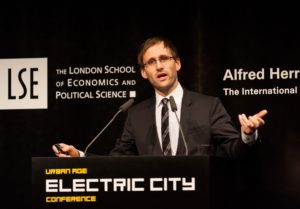
Philipp Rode introducing Continuity or Disruption: the impact of new urban tech.
As Ricky Burdett, Professor of Urban Studies and Director, LSE Cities, and Philipp Rode, Executive Director, LSE Cities, explained, the first ten Urban Age conferences tackled issues of the urban economy, health and well-being, violence, security, social inclusion and design. They dealt with the relationship between the formal and the informal city. Now that climate change and economic pressures continue to define today’s urban realities, the focus of Electric City was on ‘the challenges and responsibilities faced by cities in the digital age.’ The ‘general slogan of the smart city is not adequate to capture the social, economic, cultural and political complexities of today’s cities.
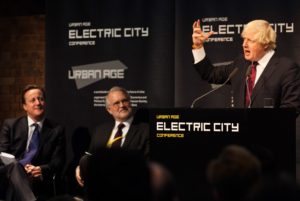
Prime Minister David Cameron, LSE Director Craig Calhoun watch London’s Mayor Boris Johnson presenting the Tech City.
How can we talk about the smart city without calling it ‘the electric city?’, asked Burdett: it has to be enabling; it has an historical and a future significance. One of the narrative threads over the two days was the traditional grand vision mechanisms of cities, urban masterplans, and the signifying role of architecture, played out as speculation on their adaptive roles.
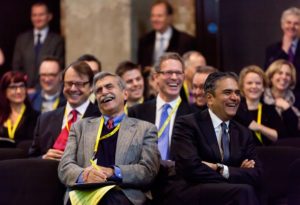
The audience at Electric City responding to Boris Johnson’s presentation.
Since the word ‘masterplan’ nowadays easily connotes any treasured vision, one such singular concept was heralded on the first morning by the combined forces of David Cameron, the British Prime Minister, and Boris Johnson, London’s Mayor, entering the proceedings from the side door in an upbeat mood to announce £50m investment in a new technology centre at the Old Street ‘Silicon’ roundabout as part of the government’s Tech City initiative to encourage growth, stemming from Shoreditch and east London’s already burgeoning clusters of tech companies. The site is arguably not the most accommodating location for such a resource, and the visualization by 00://, a London-based architectural practice, was clearly just a quickie, to underline that London was ‘the tech capital of Europe, if not the world’, as Boris put it, hastily pointing out in a more regionalist frame of mind that the bank ATM was invented in Enfield and that Jonathan Ive of Apple design fame hailed from Romford.
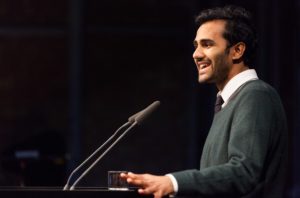
Rohan Silva on a national strategy for the urban tech revolution.
The next day, Cameron’s Senior Policy Advisor, Rohan Silva, discussed the thinking behind UK government interest in Tech City and its plans (entrepreneur visas, apprenticeships, and so on) and its national strategy for the urban tech revolution. ‘Bottom-up clusters go with the grain and DNA of London – they can trump the masterplan (approach)’, he said, ‘Wren’s masterplan after the Great Fire didn’t come to pass’ (actually that was because neither he nor the King owned the land. Over to you, Boris). But his point was well made, that in the 21st century we should relish the bottom-up, draw on collected data, spatial analysis and mapping, which was part of the notion of an open city, making it more resilient. He cited the work of the Open Data Institute (set up by Sir Tim Berners-Lee and Professor Nigel Shadbolt in Shoreditch), which aims to catalyse the evolution of an open data culture to create economic, environmental, and social value.
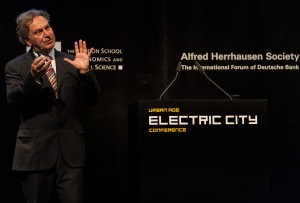
Wim Elfrink, speaking on high tech solutions for an urbanising world.
There is a need to foster transition by collaboration. But there are obstacles which go beyond silos. Burdett and Electric City co-curator Philipp Rode (in the Urban Age newspaper produced for the conference) observe the hesitancy of city policymakers and leaders about imposing new technologies, and register the scepticism of citizens towards technological fixes and worries about data protection and affordability.
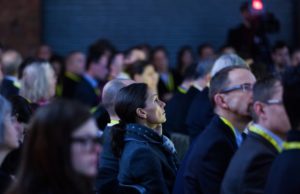
A captive audience at Electric City.
After the posse of government figures had left, a number of speakers registered the limitations of government in devising and implementing digital media plans. In the face of public sector uncertainty about how to invest wisely, the level of R&D required for new technological interfaces remains the responsibility of corporate bodies. Companies largely perceive new technologies’ role more generically as social infrastructure in tandem with a leisure-driven commercial service identity. Taken literally, this assessment means a disconnect between needs and tools, with little added value, and only a commercially driven evolution. Wim Elfrink, Executive Vice President for the Industry Solutions Group at Cisco, did his best to counter that image, talking of the ‘industrialization of the Internet’, enabling productivity and creating new value, ‘intelligent everything, everything optimised’. He sees proliferating Smart Work Centres, for example in the industrial corridors of Delhi and Mumbai, virtual education and healthcare solution, but also ‘masterplans across the world where ICT is overlooked.’
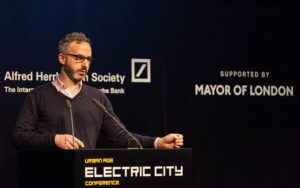
Dan Hill on the local impacts of virtual actions.
Any kind of meaningful definition of the smart city clearly necessitated the sharing of knowledge, said Craig Calhoun, Director of the LSE, in the opening sessions. The linking of infrastructure to culture, often seen as boring by comparison with the glamour of new technologies, was vital to understand, and not only as a design, demographic and financial process, but also for the scope for the intersection of sectors crucial to their success.
Clearly, in this scenario, cities need to upgrade their operating system of limited beliefs when it comes to the role of new mobile technologies. There could be far more public-private alliances to promote R&D into new, socially equitable interfaces. Gaming has inspired a lot of innovative digital media. The metaphor of the game goes hand in hand with the concept of risk. The digitally driven projects produced in the last decade or so – Brickstarter, for example, cited by speaker Dan Hill, CEO of Fabrica, fab labs, now operating in places as far apart as inner-city Boston, rural India, South Africa and the north of Norway, being another – model a customized approach to new technologies which could be increasingly coopted for localized, citizen-involved urbanism.
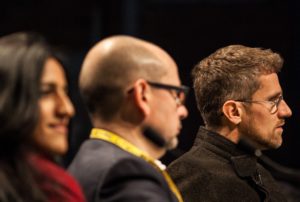
Ahesha Khanna, Mark Major and Carlo Ratti on the Culture and Innovation in the Electric City panel.
Hill, who worked on The Cloud project, a giant smart meter for London, with architect Carlo Ratti (MIT), shortlisted in the competition for the Olympic site (and won by the Orbit), put forward his response to the key provocation of Cedric Price’s also cited by Burdett and Rode; ‘Technology is the answer. But what is the question? The nub of the issue is that the 18th century institution of the industrial city is now facing 21st century problems.’ Why is it so difficult to get large scale projects like Barangaroo in Sydney’s Harbour and its Metro (on which he collaborated with Arup and Hassell) done, he wondered? There was a crisis in decision-making, on the one hand, while people can now organize very effectively. ‘What do we replace Arab Spring with?’
He reckons that infrastructure and buildings are now not what cities are about, and the most interesting, transformative uses of technology are in the hands of designers and citizens whose plans are geared towards social uses. Helsinki’s popular Food day last year, with 50 pop ups, for example, was a positive initiative, but counted as illegal behaviour as the government’s regulations restricted ‘informal, instant culture’.
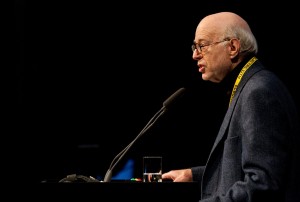
Richard Sennett speaking on the Stupifying Smart City.
In his previous role at Sitra, the Finnish sustainable innovation fund, Hill was a broker between the city and government. ‘Most governments don’t know how to design social media’, he felt. In making that necessary transition from ‘activism to activity’, it is ‘the ‘institutional response to change’ that is needed, and that demands defining ‘what and who the city is for, and how to achieve it.’
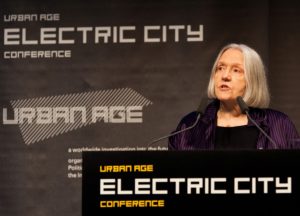
Saskia Sassen’s presentation on urbanising technology.
This positive definition could be extrapolated from the process of spelling out the limitations of the smart city. Professor of Sociology, LSE, and University Professor of the Humanities, NYU Richard Sennett’s chief set piece at the event was to witheringly critique the ‘stupifying’, simplifying spatial effects of two recent ‘smart cities’, Masdar (masterplan by Foster + Partners) in Abu Dhabi and Songdu International Business District (masterplan by KPF), a new ‘smart city’ in South Korea along Incheon’s waterfront. Masdar is ‘very Fordist’ with ‘tight form and function and no fuzzy edges’.
‘An experiment’, as Saskia Sassen (Robert S. Lynd Professor of Sociology and Co-Chair Committee on Global Thought, Columbia University) described it, it fits the bill of Sennett’s ‘stupefying smart city’ because it ‘deprives us of the ability to develop street smarts, while Songdu deprives citizens of the ‘horizontal value’ of streets, which he calls the ‘visual vector for the experience of other people’, and simply stacks up accommodation. By contrast with the impulses of many architects, the role of IBM, and Cisco in Rio, for example, is coordinating, rather than predicting, what should be happening on the ground, by ‘dealing with the complexity of the ground instead of trying to preclude it.’ These two examples underlined how heavily the 21st century smart city masterplan is about city as product: there is ‘money to be made from closing the system’, said Sennett.
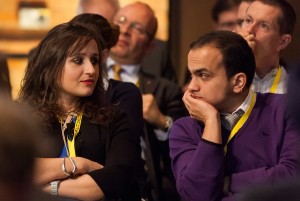
Marina Montero Carrero and Omer Cavusoglu, LSE Cities.
But an alternative city model is possible, said Adam Greenfield, MD of Urbanscale in NYC, a firm specializing in networked IT in cities, and he praised the work of IBM, Siemens and Cisco, and new software platforms such as the Living PlanIT Urban Operating System that accelerates the development and deployment of urban technology and connected devices, providing ‘occupier support’. Could these innovations be reconciled with such traditional urban ideals as Le Corbusier’s La Ville Radieuse, he speculated? The limitation of a top-down ‘God’s eye perspective’ was the abstracting nature of ‘the greenfield, any space’ approach in which ‘an optical order was consecrated for a management operation’.
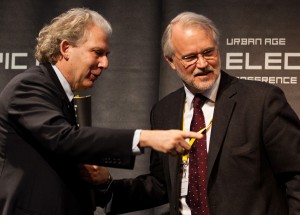
Craig Calhoun and Ricky Burdett.
Craig Calhoun, in the discussion on urban responses to climate change, felt that today’s solutions were not dependent on masterplans, and saw cities as sites of self-organisation and collaboration. ‘The process of repurposing of infrastructure requires us to get over often highly individual techno-fantasies’. We have the capacity to create a politics that enables us to use the necessary technologies to ‘create interdisciplinary structures’. One problem, felt Maarten Hajer, Director of the Netherlands Environmental Assessment Agency, was that ‘most politicians only dare follow major issues. They codify something that is already happening.’
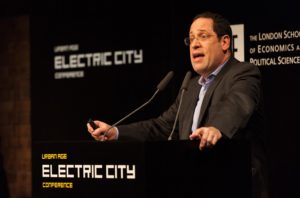
Bruce Katz, speaking on the green economy of US metro regions.
However Bruce Katz, Vice President of The Brookings Institution and Founding Director of the Brookings Metropolitan Policy Programme said the ‘clean economy’ was in the hands of metropolitan regions in the States, and with more jobs needed, it was ‘as big as bio-sciences’, and paid ‘higher than median wages.’
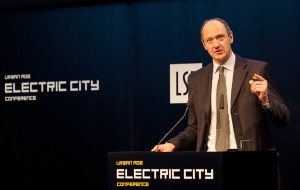
Roland Busch from Siemens on the new urban infrastructure business.
With Federal government scaling back, states themselves are setting standards, he added, citing San Diego’s electric car infrastructure, Boston’s Innovation District and Denver’s Light Rail. Further countering any suggestion of narrow solutions on the commercial front, Roland Busch, CEO, Infrastructure & Cities Sector, Siemens AG, said the firm has created a ‘data fusion centre’, with one centre of information covering the decentralized energy management of smart grid solutions, energy efficient buildings, rail-bound transit solutions and intelligent traffic management – themes flagged up in Siemens’ new global urban sustainability centre at Royal Victoria Docks in London.
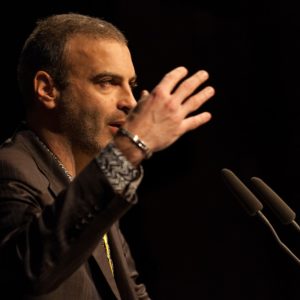
Dimitri Zenghelis speaking on the green economy: a global perspective.
Having a more holistic approach and benchmarking cities eliminated the silo mentality, he maintained. ‘Weath is important, but the right policies matter more.’
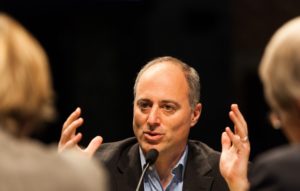
Andy Altman, chairing the panel on the legacy of urban leadership.
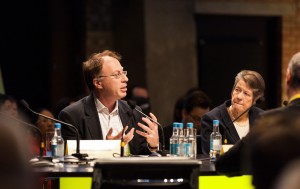
Jeremy Oppenheim, McKinsey & Company, and Judith Mayhew Jonas, Chairman, London & Partners, on the panel, A new climate for the urban economy?
The hazards of cities not planning for a change in resource prices were pointed out by Dimitri Zenghelis, Visiting Senior Fellow, The Grantham Research Institute on Climate Change and the Environment, LSE, who said that low resource cities were ironically more expensive. These issues ‘land in space’, felt Andy Altman, formerly Chief Executive of the LLDC and now a Senior Research Fellow at LSE Cities, based on his experience guiding the legacy of the Olympic Park, and the ‘technological masterplan must sit within the context of your physical centre.’
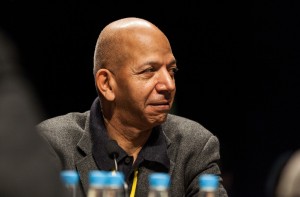
Antony Williams on the legacy of urban leadership panel.
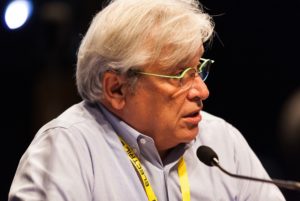
Joan Clos on the legacy of urban leadership panel.
But ‘don’t replicate every solution everywhere’. Cities experiencing population growth ‘can only address issues if we create new ways of participation’, advised Jeremy Oppenheim, Director, Sustainability and Resource Productivity Practice, McKinsey & Company. Meanwhile, David Willetts MP, Minister of State for Universities and Science, said that the government’s Technology Stategy Board had now launched the Future City Catapault vision, testing innovative business solutions for cities, and reminded us that the UK was a leader in energy-efficient computers and wrote ‘very smart algorithms’. Once the delays in the programme for introducing Galileo, the European Global Satellite-based navigation system, which doubles the number of satellites to ‘make very accurate GPS data more accurate’, had been overcome, things would be better.
Throughout the Electric City, the potential future digital operativity held sway in two alternative guises, a scenario experienced at previous Urban Age conferences, with, in the search for a really smart answer, the top down approach to urban evolution and the bottom up of participatory urbanism, the former coming under fire in favour of the latter again and again. Many speakers underlined the obviousness of the city as an abstract terrain for the operation of market dreams, which ‘catch us in industry pilot projects’ (as Tony Travers, Director, British Government, LSE, put it); one or two were apt to denigrate the role of architects in this scenario, while in the final session on the legacy of urban leadership a number of figures, some of them long game players in Mayoral office, tried to put a set of integrative strategies for cities, applicable now, on the table.
Based on his extensive experience in urban regeneration, Antony Williams, CEO and Executive Director, Federal City Council of Washington DC, advocated using a project to bring change, as Tech City was aimed at. ‘Make everything transparent’, said Antoni Vives, the more recently elected Deputy Mayor of Barcelona, said. ‘We need to build a whole new business model with social orientation embedded into it.’
Most urbanism is wrong, he pointed out, a sentiment echoed by Joan Clos, formerly Mayor of Barcelona, and now Executive Director, United National Human Settlements Programme, because it borrowed the worst systems of urbanism from elsewhere, like gated communities, signaling the end of street life. Isabel Dedring, Deputy Mayor of London, felt that ‘design really engages people, it promotes dialogue – we are not making enough of that. We should find a mechanism to show the trialling of change.’ There is, then, a new platform to be created, concluded Andy Altman, in the chair. ‘Leaders get the new infrastructure, and it requires a new knowledge.’
Interfacing well with that challenge, Wolfgang Pietsch from the Munich Centre for Technology in Society, who is studying big data, said that the biggest challenge is understanding how network societies are now determining patterns of freedom for their use. ‘We need a debate on how it is employed for the human good.’ What happens in urbanized areas during global disasters puts the identity of digital technologies in sharp focus, as Greenfield pointed out, for during Hurricane Sandy this autumn people made better use of information they retrieved by digital means than FEMA and other organizations: this spontaneity is to be valued. He concurred with other speakers that people self-organising brought out resources they didn’t know they had, with this formation of networks part of a reconceptualisation of themselves as actors, rather than as passive observers.
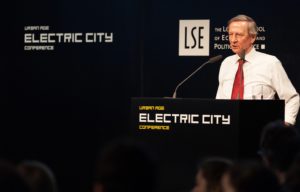
Anthony Giddens’ keynote, Reindustrialization in a new electric age, in the urban response to climate change panel.
In the face of climatic change induced disasters, for which meteorologists have been prosecuted but governments have not been taken to task, do we not in any case constantly overestimate the powers of technologies on cities?, asked Michael Kimmelman, the New York Times’ architecture correspondent. ‘Smartening’ up a city should be about democratizing its resources, for example, city libraries becoming community centres, he said.
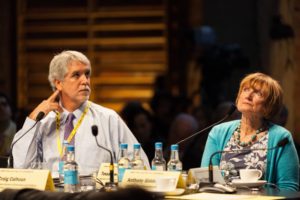
Enrique Peñalosa and Tessa Jowell MP on the panel, an urban response to climate change.
How far is it possible in any case to programme against disruption?, Geoff Mulgan, Chief Executive of NESTA, asked, chairing the Culture and Innovation session. Anthony Giddens, Fellow of Kings College, Cambridge and Emeritus Professor, LSE, who was the Climate Change keynote speaker, said that we had ‘lost control of climate change’, but we were not to just see that as negative but as a designation of the risks we face. How were we to achieve peace and security in an age of rubble?
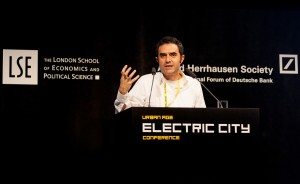
Alejandro Zaera-Polo speaking on the impact of digital technology on the space of the city in the session Designing place for the digital age.
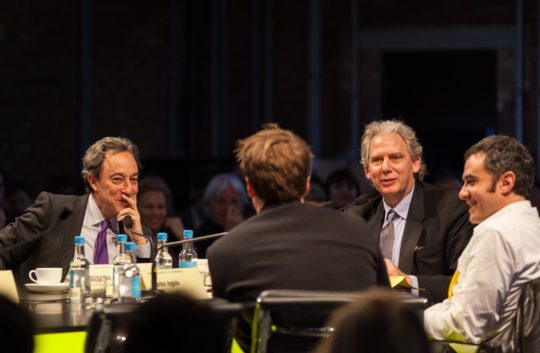
Michael Kimmelman, Bjarke Ingels, Ricky Burdett and Alejandro Zaera-Polo in the session panel for Designing space for the digital age.
Recognising the reality of risk was the first step. Moreover, living as we do in the Third Industrial Revolution with fab labs, reversing the idea of manufacturing, and entertaining the visions of people like Neil Gershenfeld at MIT who has speculated about a plane that could fly out of a computer, we can think globally and manufacture locally, with numerous consequences.
‘Is everything different today because of technology?’ wondered Carlo Ratti, Director of MIT’s Senseable City Lab. With their proliferating sensors and actuators, cities are ‘starting to talk back to us’, which is still a ‘tentative field of practice’. Many are familiar with interactivity in leisure contexts, and his Living Water wall at the Zaragoza Water Expo a few years ago, is an example of the creativity of custom-designed interactive installations in public spaces to foster a sense of play. He stressed the by now widely perceived point that that wifi changes people’s working habits, and activities overlap in urban spaces far more than the rigid vision of La Ville Radieuse ever allowed for. Rounding off the panel discussion, cities operate as a balance of chaos and order, said Enrique Peñalosa, former Mayor of Bogota, echoed by Sennett, who added that the more technology there is in cities, the more the developmental and psychological issues have to be considered.
Opening a promising seam of conjecture about a potential new role for architecture in digitally driven network urbanism practices, Alejandro Zaera-Polo, the founder of AZPA and Dean of Architecture at Princeton University, told the audience about the Culture Now, Web 2.0 studio he led recently at Princeton. The phenomenon of Web 2.0 has affected all aspects of daily life, with new domains of e-commerce, social media and networking. Many Web 2.0 companies have moved into geo-referencing, with GPS-enabled smart phone tools like Foursquare and Google Latitude that interface between information and the physical realm.
What happens when knowledge is crowdsourced? Certainly, one effect is that the prevalence of location-focused devices challenges the principles of architecture and opens up new perspectives, said Zaera-Polo. In citing firms like Pachube (now Cosm) offering scaleable platforms connecting devices, products and apps of the Internet of Things, he put his finger on the evolutionary digital ecosystems of custom-made elements that cities can benefit from.
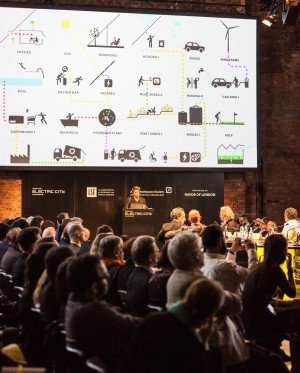
Bjarke Ingels speaking on Meaning and Symbolism in green architecture and urbanism in the session Designing place for the digital age.
In the Princeton studio, his students developed diagrams of networks for rechanneling food waste, for example, based on the actor-network theory, the agent-based approach to social theory and research developed by Latour, Callon, Law and others, which maps relations between things and concepts. The studio looked at 2.0 corporate models such as Kickstarter, Indaba and Zoko, to analyse how hybrid interfaces could evolve through physical hubs for social interaction becoming connected to specific web and mobile-enabled networks.
The architectural spectre evoked by Zaera-Polo departed from a parade of new architectural monumentalism. It is not about ‘parametric, pliant form’, but a canon that could ‘discretised, customized – the near devolution of design agency’ through crowd-sourced, DIY intelligence. This will mean that ‘the relationship with the client will be different’, and the challenge to ‘invent a project and see if it takes, with a multitude of clients.’ Investigating the city as an ‘accretion of cells..and incompleteness’, Andrés Jaque Arquitectos + Office for Political Innovation’s IKEA Disobedients performance for MoMA PS1 (2012) conveyed the spirit of what Zaera-Polo had in mind. Its setting of IKEA-hacked pieces moved on from IKEA’s perfect domestic ‘republic’, and ongoing research of community living spaces defined home as a hybrid, semi-public space. As with the Wiki-house, it is driven by low technologies and combinatorial as a concept.
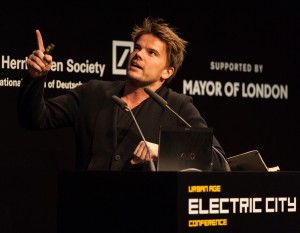
Bjarke Ingels.
Like a number of people excited by the potential of non-plan of the 1960s, Zaera-Polo said these ideas were also reflected in the open systems of architects such as U-TT, Alejandro Aravena (Elemental) and Giancarlo Mazzanti. The slum’s ad hocness makes it a latent paradigm, he added, and concepts of urban recycling can have ‘great impact on how the city can be used.’
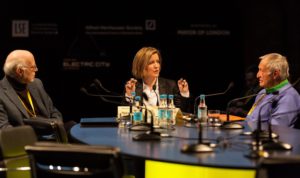
Richard Sennett, Deborah Saunt (chair) and Richard Rogers discuss the implications for the public realm.
Architect Bjarke Ingels, speaking next, told the audience about upturning Copenhagen’s homogenous ‘good’ public design image, by managing to borrow the mermaid emblem of his home city for the Danish pavilion at the 2010 Shanghai World Expo. It is a good story, and perhaps a sign of Copenhagen as the smart city that doesn’t take itself too seriously BIG wishes to advance further through its tactics, Hedonistic Sustainability being one of them. Ingels is also wedded to the idea of new hybrids, citing his recently bi-national (Sweden and Denmark) Loop City conceptual masterplan, which has a smart grid, and waterfront waste treatment plant in Copenhagen, to be the biggest building in the city, which reinvents the factory as a mountain with a ski slope, hybridizing utilities and culture.
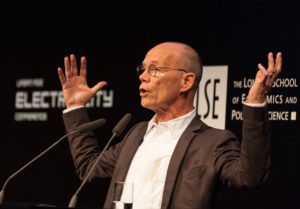
Erik Spiekermann on mapping and designing urban systems in the session Designing place for the digital age.
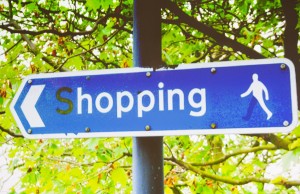
Make urban planners laugh! Image from Erik Spiekermann’s presentation Mapping and designing urban systems.
Instead of a distanced design exercise, the Superkilen public space project BIG realized with Superflex and Topotek1 in the most ethnically diverse neighbourhood of the city Ingels called ‘an extreme exercise in inclusion’ and public participation. This universal garden of elements sourced from many cultures he reckoned was ‘a more truthful portrait of Copenhagen’ today.
While Richard Rogers, another architect present at Electric City, discussing the implications for the public realm with Richard Sennett, chaired by Deborah Saunt, Director of DSDHA Architecture and Urban Design, said later on that day that his high-tech architecture had ‘made technology aesthetic’, the graphic designer Erik Spiekermann, CEO of EdenSpiekermann, responsible for Legible London, talking in the Designing Place in the Digital Age session, called himself ‘a translator’. He pitched the idea of turning old telephone booths into charging stations, advocating user-centred design, making it ‘ubiquitous, easy and fun.’ The ‘trample path’ that people carve out of green space, or playful adjustment of street signs, showed that people will go their own way – cities are messy things.
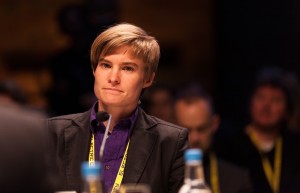
Frauke Behrendt speaking on smart e-bikes in the session Continuity or disruption: the impact of the new urban tech.
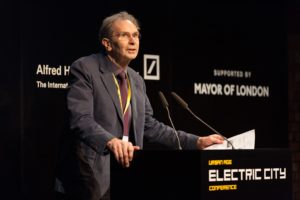
John Urry speaks on sociotechnical advances for the future of the city.
All citizens would like to navigate their terrains with ease, a key lever in achieving social equity. Julio Dávilla, Director of the Development Planning Unit at UCL, told the story of the upgrading of informal settlements of Medellín in Colombia, including the city’s implementation of MetroCable routes connecting hitherto remote barrios. When it came to cars, the session on new urban tech on the first day registered that from 2000-2010 there had been a 16% decline in driving licence holders. A shared electric vehicle system like car@go from Daimler, explained by Rainer Becker, Chief Operating Officer, represented a very flexible emergent mode of transit, but the costs of parking need to reduce to be viable.
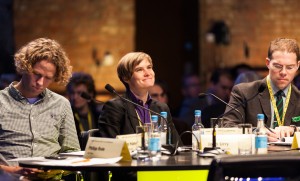
Tom Hulme, Frauke Behrendt and Greg Lindsay in the session on the impact of new urban tech.
Frauke Behrendt, Senior Lecturer in Media Studies, University of Brighton, testified to the explosion of interest in e-bikes, especially in China and other Asian countries which could charge without a specific infrastructure. ‘How can we effect synchronization across different sectors?’, asked John Urry, Professor of Sociology at Lancaster University, quoting Buckminster Fuller who said build a new model that makes the existing model obsolete. Behrendt’s monitoring of 35 bikes, through the use of sensors, could, in our era of the Internet of Things, indeed guage many things to help evolve the system.
What about smart living spaces? There was not much at Electric City on how to become more ‘prosumerist’ in clean energy terms. However Kent Larson, Director of the Cities Science Initiative at MIT, observed that ‘millennials’ were interested in services, not in houses. Hence a transformable cityhomes prototype with a chassis designed for different infills. ‘I don’t believe in smart homes, but bringing smart things in’. It has shared desks, a fab lab, recreational space, sensor networks, food on demand, an idea that they are looking to their sponsors to develop. The anti-urban impulses of the dotcoms was flagged up by Greg Lindsay, journalist at Fast Company and a Visiting Scholar at NYU 9 (‘How can you bring the city into the office?’), together with the phenomenon of the ongoing reduction in office space in the US, which would make MIT’s prototype more flexible.
By 2018, an incredible 14 times more data will be generated by smartphones, said Patrik Cerwall, Head of Strategic Marketing at Ericsson, and 85% of the world’s population covered by high-speed Internet. At the moment, in Africa, as Edgar Pieterse quoted, only 28% of the labour force are in a stable job, so the potential of smart tech is immense, but so is the responsibility attributed to it. ‘Is there a way of having a collectivism beyond the market?’, asked Greg Lindsay. Because, for all the fears of imposed systems, and indeed the environmental costs of computing and e-waste, ‘technology is enabling us to make collective action less scary’, reckoned Tom Hulme, Design Director of IDEO, London.
Electric City raised a whole heap of questions about smart tools and allied motivations concerning the future of the urban domain, and it was Saskia Sassen who summarized it so illuminatingly on the first morning during her presentation Urbanising Technology, when she said that in ‘the challenge of preserving what made cities outlive empires’, the best answer is more speculation in this period of inspiration, with ‘ecologies including the logic of users. We can diverge from the engineer’s logics and can hack them. In that divergence is a space for open source urbanism.’